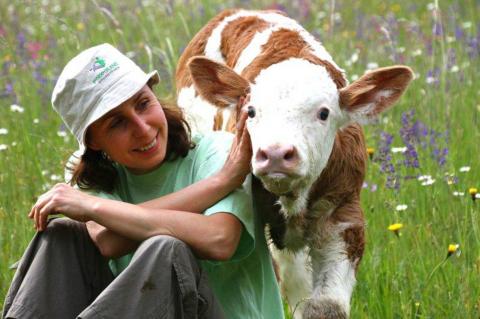Farma pod Melichovou skalou

Higher
The farm "Farma pod Melichovou skalou" is located under the cliff of Melichova skala in the locality Skliarovo near the town of Detva, in the southern Podpoľanie region, central Slovakia. Vágner family moved here in 2005 and has been doing business in agritourism and dairy production since then. Their daily work means taking care of the landscape and producing high quality farm products. The family is proud of this approach. The traditionally used agricultural landscape offers, besides its attractive appearance, the possibility to pick up medicinal plants and fruits. The nearby protected area is interesting for its rocky cliffs and forest stands.

Higher
| NUMBER OF WORKERS | FAMILY MEMBERS | EXTERNAL WORKERS |
|---|---|---|
| Full time | 1 | 0 |
| Part time | 3 | 0 |
The farm is located in a "transition zone" of the MaB UNESCO Biosphere Reserve and the Protected Landscape Area Poľana. The Poľana stratovolcano mountain is covered by scarce forests with occurring only cliffs locally. The cliff Melichova skala gave the name to the farm. The farm is a part of the scattered settlement that is characteristic for the Podpoľanie region. It is well known in Slovakia and also abroad mainly for its traditions and folk festivals. Folk traditions are maintained also by Vágner family. Their farm as well as other farms cultivate land plots rich in history that are well preserved in the region. Private plots have never undergone land consolidation reforms during the Communism regime due to their low fertility. Life was hard here, and many families left. In recent years, they have come back followed by newcomers from other regions, not only for agriculture, but also to establish an agritourism business. This is the case of the Vágner family as well.
From the point of view of multi-purpose and sustainable agriculture development and agritourism support the inclusion of a traditionally cultivated farmland into the transition zone of the MaB UNESCO Biosphere Reserve and the Protected Landscape Area Poľana was consider to be a very important step for residents. They also expressed their views on the issue in a referendum. The locals understand that the countryside has an exceptionally high potential for agritourism activities while its potential for agricultural production is extremely low. The value of the landscape was the most important aspect for Vágner family to move in and to start their business activities. They feel like home here and their attitude helps them in in their daily routine. Traditionally cultivated plots are attractive for their guests and tourists passing along their farm on a nearby road. The family is an exceptional example of how living on the agricultural landscape in Slovakia should look like.
"Even though we are aware that family-based agri-business is a difficult way of living, we simply love farming, and the surroundings we live in helps us overcome obstacles and live to the fullest every day.”
Although the farm owners have some training related to entrepreneurship activities on the farm, they say that complicated legislation is the most discouraging factor for the establishment of a family-run farm. From the experiences of other farmers they know that this issue is discussed widely almost at all small and family-run farms. There are many obstacles imposed by legislation, but the farm refuses to let go of quality at the expense of quantity. Such an approach is not common among business people. Therefore, start-ups and as well as established farmers need further education in the field of marketing and maintenance of landscape values in relation to food quality. The Podpoľanie region is an ideal example of how land cultivation in a traditional way at an extensive area should look like. However, many homesteads are abandoned and the land in their neighborhood is not maintained, thus negatively affecting major advantage of the territory - the specific landscape character that tourist are searching for. From the experiences of Vágner family arises yet another long overlooked problem - a suitable farm or homestead is not easy to obtain due to constraints which were caused by original owners when selling of properties (owners were not able to find consensus for the farm sale). This situation is one of the main obstacles for further development of multi-purpose and sustainable farming there. Another problem is insufficient infrastructure. Visitors from Slovakia but also foreigners are attracted to this region by its tangible natural, cultural and historical heritage as well as folk festivals and cultural events aimed at promoting traditional crafts and products during summer seasons. On the other side, the tourist potential of the country during the winter season is still untapped.
| Strengths | Weaknesses |
|---|---|
|
|
| Opportunities | Threats |
|
|
Multi-purpose farming activities of the owners were developed without any educational support or advice regarding sustainable agriculture. They found inspiration for their current business abroad where they worked on farms and brought their experiences back to Slovakia. Concurrently, based on the knowledge gained at universities, they were able to implement the landscape characteristics into their business model. When they needed advice, former classmates were available to provide support (for instance product processing). Their children also join farming activities. This concept is extremely powerful and useful since the owners help their children making independent decisions in the future and teach them basic agriculture skills which they can use in their future job. The family is involved in the cultural life of the region and takes a part at folklore events. These activities support the local identity feelings of all family members and give them the feeling of usefulness, belonging into the local community.
- Which type of knowledge and information on the landscape type would be provided to young farmers with regard to adequate maintenance of the agricultural land with a specific historical character?
- Do you have any catalogue of (visual) attractions or objects of natural, cultural and historical value that are interesting for tourists and which would boost agritourism?